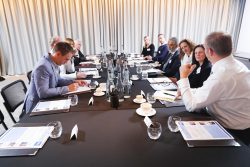 DELEGATES:
DELEGATES:
Clare Burles, People Director – Virgin Trains
John Greatrex, Group HR Director, Unipart Group Of Companies
Tracy Greenfield, HR Director – Leidos Innovations UK Ltd
Davinder Gujral, Group HR Director – Edwardian Hotels London
Brian Newman, Vice President – Human Resources – Live Nation Entertainment
Claudia Quinton, Head Of Workplace Transformation & Consulting – Sopra Steria
Zoe Rocholl, HR – Associate Director, Mace Group Ltd
Steve Rodgers, International Recruitment Manager – Ocado Technology
Diane Smith, Head of Talent, Learning & Development – Babcock International Group
Ian Thomas, Managing Director, UK Commercial Sector – Sopra Steria
Businesses have been focused on staying competitive in protracted challenging times. Employers now face what is often described as “a perfect storm”, a swirling maelstrom of scarce skills, static economy and the resourcing and business uncertainties of Brexit. The core resourcing concerns for HR; attraction, recruitment and retention of valuable employees, may not be new, but competition between employers for talent has never been hotter.
As the world of work continues to Change, how is employee experience Being re-defined?
Brian Newman: It’s about the overall way that our people engage with us. It hits every single part of the employee life cycle – we have to make it all accessible. We are all in a talent war.
Davinder Gujral: We start engaging employees from the very beginning when they are prospective employees, that’s where I believe that engagement begins. This perspective continues once an employee is on board, if we are in a situation where any one of our diverse workforce are not performing to the level or the expectations of the organisation, we start working closely with them. Why have they not performed? Is it something that we missed? Did we not make the right effort to train them? Did we not provide them with the right leadership. We look at leadership itself being an important catalyst as far as engaging the workforce is concerned. By definition it is not attrition, it’s turnover.
Clare Burles: The rail industry traditionally has very low attrition which some other sectors would welcome, but it presents its own challenges. From an engagement perspective we actually look at the data which comes through our annual employee survey and we can cut this and use it to look at how engaged our employees are by length of service to understand how engaged our longer serving employees are compared to the people that we’re bringing in as new starters. Then we can use different interventions and approaches to address these differences and preferences. The results are typically those with less then two years service are highly engaged compared to those who’ve been working at the company for say 15 years.
Steve Rodgers: Our output is a retail business but it’s the technology that drives it, without the technology we don’t have a retail business. Over the last couple of years, we’ve really looked at, defining our culture, to try and meet those employee expectations and I think that’s one of the key measures. I talk to numerous candidates in my role at various levels and every individual has an entirely different expectation, so the view we’ve taken is let’s set our stall out, and be very clear about what our culture is.
Diane Smith: Expectations and standards being the starting position resonates with me too. The geographic spread, volume and significantly varied size of our sites means that we have to recognise that we have micro-cultures that impact on the day to day experiences of our people. This means it is critical that we have very clearly defined standards and expectations.
Tracy Greenfield: Leidos recently integrated Lockheed Martin’s Information Systems and Global Solutions (ISGS) business. We are working on some really exciting HR programmes for future growth including, Foundational HR investments. Over the last 18 months we have been laying the foundations for growth. Our next stage in the journey is investing in our people, our culture and our values: integrity, innovation, agility, commitment and collaboration, bringing the words to life for all our employees in the business so that we achieve ‘true’ employee engagement and customer engagement.
Claudia Quinton: The speed that industries are moving at, they’re all accelerating in terms of the rate of change. I think that impacts on our employees and our ability to retain them, the loyalty is disappearing. Everybody has different challenges in various different industries and we all try to use our joined-up knowledge to tackle these things. There is a lot of disruption everywhere you look, and the one thing that I fundamentally struggle with as an HR director is, how can I empower people?
Brian Newman: Empowerment, can either mean giving them the keys and telling them, “Off you go,” or this kind of slightly strange world we sometimes live in which is, “Take lots of risk and innovate but only do it within these four walls so that we can control the risk and make sure that we check the risk.” That doesn’t actually sit properly with tech populations, they want to be given new things to play with all the time, and this note of disruption is key to that.
Ian Thomas: I think that’s absolutely right. If we say you’re empowered but only if you do the things we expect you to do, that isn’t empowerment, and we have to be honest about that. Empowerment is; ‘we all agree the things we’ve got to achieve, you’re the best placed to figure out how to do that, off you go’. But then you’ve got to believe it. You’ve got to then let people go, because it’ll be ten times worse if you claim empowerment and then don’t really empower people. It’ll make it worse, not better, in my view.
In terms of qualitative information, Data and analytics, do you feel Confident that you have the tools and Analysis capabilities to know enough About your existing employee Behaviours, motivators as well as Disruptors and disablers, and can you Identify the pain points?
Davinder Gujral: To an extent, employee surveys can be judged as looking into the rear-view mirror. From the analytics point of view, employee surveys do tell us how our workforce is feeling at any one moment in time, and in terms of innovation we’ve taken that one step further. We’ve started looking at ‘well-being and happiness’ surveys. We combine these with our annual appraisals with a view to empowering our colleagues. Empowerment can be interpreted in different ways, so how do we gauge that they are empowered? Part of that gauging comes from autonomy.
Clare Burles: It is backwards looking, but it’s only one of many tools we use throughout the year to get a temperature check on how our people are feeling. What the survey can help with is to enable and inform some of the immediate decisions you’re making in terms of the business based on employee feedback. We also do a lot of activity which faceto-face engagement throughout the year, which gives our employees who are based at different locations their chance to have their say. And over the past two years we’ve been upskilling managers and giving them the tools they need to do the job.
Steve Rodgers: We do annual engagement surveys, and we’ve recently introduced pulse surveys because we’ve realised measuring annually, retrospectively, adds little value. By the time you’ve analysed the data and started doing something about it, you’ve probably gone several more months down the line and actually employees feel that nothing is being done. The reality is we’re still working on the outputs of the last survey, with the next one fast approaching. There’s a huge lag in the system.
Are traditional employee surveys, And annual performance management Redundant now?
Diane Smith: Both still have a place however we must also recognise their limitations. On that basis, as HR professionals, we should review approaches, ensure they are fit for purpose and also that they are key enablers to action. We are working with our managers to encourage the use of regular, quality conversations, to increase employee confidence in being able to share their opinions, discuss aspirations and convey views on challenges.
Brian Newman: I would challenge the idea of predictive not being useful. It strikes me as maybe overlooking an opportunity to use data to provide insight through really collapsing what’s meaningful and getting rid of all the other noise. We plough a huge amount of insight and science and predictability into recruiting, so we use psychometric surveys, we use competency based interviews, and then they arrive and we’re already worried about what they did yesterday rather than what they might do in the future. I think we’re missing a trick.
Claudia Quinton: There’s a correlation between what you value as an individual and how you’re going to fit with the organisation, I don’t think anyone’s ever delved into it. That data exists but we don’t mine it within the HR community and I’m not convinced that any of us would know how. We do need to embrace it, we do need to understand how best to mine it, and we need to not be worried of it.
Tracy Greenfield: We live in a digital world of real time consumption of information. ‘Generation Me’, wants to give real time feedback to leaders -not through an annual surveys or a six-monthly surveys – but with weekly or even daily feedback. The technology we are delivering to our customers, be it predictive data analytics or simplifying user experiences is something that we need to bring into the HR team and function.
Clare Burles: Internally, we don’t apply the same amount of investment or focus on the insight as we do for our external customer. We talk a lot about our internal brand mirroring the external brand but where insights are concerned we’re not in the same place at the moment. It’s an opportunity for us though as it will help us recruit and retain the very best people.
Ian Thomas: That’s a fascinating point. We put a huge amount of effort into trying to figure out what the customer wants and almost none into what the employee needs.
Brian Newman: Millions of customers creates good trend data that you can take insights from. Thousands of employees is a little more difficult because it skews heavily on small variances. But I also think, in terms of prognosis, connecting some of the parts needs to happen too. For example a nine-box grid talent matrix should connect to bonus review, connect to future recruitment decisions where you can highlight who the best recruiters are because we always end up with slightly better talent matrix results.
Tracy Greenfield: We do know the right questions to ask, so it is about working in partnership with our technical teams such as our data analytics team to help us with the answers.
In terms of stakeholder understanding And buy-in for improving employee Experience. How would you frame a proposal to invest in improving employee experience, and has your Organisation currently embraced such Engagement initiatives? If not, what are The key reasons why?
Tracy Greenfield: If employee engagement was on the balance sheet of businesses, we would be having different discussions in boardrooms. We need to be having more conversations around employee engagement and culture. We are definitely moving in the right direction and with more C level HR representation at the board, it will be only be a matter of time.
Diane Smith: Developing an understanding of why people stay and what value they feel they bring to the organisation can be a powerful tool in defining attraction and engagement strategies. One of our specific areas of focus is to challenge current practices and assumptions about employee expectations.
Steve Rodgers: The real key to employee engagement for me is what happens at the team level, and it’s that investment in line manager skills that’s important. We’ll all be able to name line managers that frankly shouldn’t be managing anybody and we’ve been quite proactive at improving that by doing a lot of work to better define career paths to improve employee experience.
Diane Smith: On that point it’s quite a conflict in terms of managing those expectations because the nature of the workplace is continually evolving and changing. Having the resilience to live with ambiguity is key for young people entering the workforce and it is often down to the line manager, and those mentoring them, to help them navigate this environment.
Ian Thomas: Agreed, the old adage of people joining companies and leaving managers is as true now as it was 50 years ago, and great line managers are the ones making a difference to the environment. They’re the ones making a difference to the level of true empowerment to the employee experience, not the senior management and not us, it’s getting the line managers on board.
Brian Newman: There is a trade-off, better digitalisation of HR and utilising systems gets rid of things like performance appraisals, which take hours, to freeing a line manager to manage is perhaps the greatest opportunity for HR to facilitate that journey.
There are many potential disruptive Influences on engagement. What have You observed and what causes a Deterioration in employee experience And how can these be best identified And actioned upon?
Brian Newman: There’s a demise of collective representation. We’ve experienced a very small minority that have a very loud voice, and social media enables that. My leadership, receive a message that say, “It’s a disaster and it didn’t work.” One message from 10,000 people” can be a real disruptor, and this open communication, whilst I love it, it can be disruptive.
Tracy Greenfield: Indeed, the use of social media makes it easy for employees to express their views on the business. We need to take unstructured information and review the whole picture to help determine what we need to focus on. In my experience the most disruptive employees in the business can be the biggest advocates in any change programme.
Clare Burles: We have a number of ambassadors across the business that want to be leading and supporting where we’re heading as a business and be involved in what we’re doing so we use those people to help support the business during times of change. It’s a really positive step forward, but it was important not to just choose the ‘good’ people. We need those who aren’t afraid to speak up and challenge.
Diane Smith: Employee experience is influenced by the quality of the relationships and experiences people have with those around them. At the moment we are actively working to increase levels of confidence to be respectfully honest and open. In doing this however it opens the door for a potentially uncomfortable conversation. Equipping our people and managers to do this encourages an openness and transparency.
Ian Thomas: The thing you learn from customer research, and I think it applies exactly the same way to employees, is encourage the feedback, don’t be defensive, always respond. It’s exactly the same for employees, because often the thing that we miss is the person who is constantly complaining. So I would say encourage that disruption and listen to what they say.
Clare Burles: The important thing is then closing that feedback loop, so it’s fine to get that feedback, but if no action happens it can have a really negative effect. There’s a risk that your employees become even more disengaged.
Claudia Quinton: We’ve touched on HR not embracing technology, not making ourselves easy to do business with. That is becoming increasingly apparent. We can take all the feedback from our employees, we can listen to them, but we also need to look at ourselves as a business and think, “How would I interact with HR if I were Apple”?
Are you currently able to correlate employee experience improvement or deterioration with customer outcomes experience and feedback?
Davinder Gujral: In hospitality you have to, because the customer is either going to come back or not. We collect feedback and data on our guests and how employees interact with guests.
Clare Burles: Our customer measure is NPS (Net Promoter Score). It’s then how do you use that data to reward and recognise the good customer experiences our people have delivered and also use it to have meaningful conversations when it could be better.
Diane Smith: We measure customer satisfaction levels in a number of ways that don’t necessarily correlate with employee experience or engagement scores. However what is key for us is the dependency on the quality of interaction at a local level and the relationship on the front line with the customer. The strong partnerships between our employees and customer are fundamental.
Tracy Greenfield: The link between making sure our employees are engaged and technically competent is key to our business and meeting the needs of our customers. We focus on the partnership and the link between employees and providing a very high level customer service.
Steve Rodgers: We provide services for business customers and end-user consumers so it’s very difficult for us to correlate employee experience with customer experience. You can rate your CSTM (Customer Service Team Member), the person that arrives at your door by their general demeanour and their courtesy, but linking employee experience to the customer experience is mainly through anecdotal evidence, through social media.
Claudia Quinton: Do you measure the link between employee satisfaction, employee experience and customer satisfaction? Because lots of companies measure customer sat, CSAT. Our research revealed half of organisations don’t take this seriously.
Davinder Gujral: In hospitality, it’s really important, because we put in a great deal of effort to do these measures through our KPIs and also through gap analysis, that really gives us a true barometer.
Ian Thomas: We measure CSAT in lots of different ways. We certainly have processes within our business where if a customer highlights where an employee has achieved something great or not, we would follow that up with recognition awards or similar. I don’t see businesses creating a causal link between, improving employee engagement by five points, will equal a three point improvement in my CSAT, which results in X millions of pounds on my bottom line. They can’t correlate the two. Can you create that causal link within your businesses, other than from an anecdotal point of view?
Tracy Greenfield: Actually, if you sidestep the annual performance cycle, you lose your annual employee survey, because you’re capturing real time feedback that’s quick and you can act on it, benefitting employees and the business.
Brian Newman: Indeed, people have lives, which means they arrive for work not in the best of moods. Nothing to do with you, the call centre or otherwise, but don’t feel like being full of happiness that day. It’s the trickiness in happiness indexes.
Claudia Quinton: We’re working with a large call centre at the moment. One of the instances where we’ve seen people coming in who are not happy, they’re not set up mentally to take the calls to deal with the customers. What it allows us to do is to intervene before that person actually makes a call. Just by taking five minutes, which may well turn out to be, “my cat just died.” “OK, hang on a sec, let’s do something about it. Go and take a day off.” You can then call the person on stand-by in to cover that shift. But the interaction of understanding what the issue is, is critical.
How can you be sure that the organisation’s culture and brand are attuned to employee experience to positively influence performance and engagement?
Clare Burles: Our founder had a famous statement which was happy employees equals happy customers equals happy shareholders and all of Virgin’s businesses are very much focused on that philosophy. So the expectation of a lot of our people when Virgin took on the rail franchise was, they expect it to be fun, they expect to be included and have a voice in the direction of the business and they expect to be listened to. The upside is the brand is very visible. People don’t want to come and work for the railway, they want to work for Virgin.
Davinder Gujral: It’s extremely important to us of course. There is, we believe, a direct correlation between brand awareness, corporate brand awareness and employee retention. How we actually promote this within our group of employees is to really ensure that they have the ability to seek a clarity. As an organisation, we’ve very transparent We practice what we say our brand is.
Claudia Quinton: Yes, there’s a link between brand culture and engagement. I think the link is tangible with customers engaging with a particular organisations. What is challenging is for HR teams to line everything up so that you can demonstrate it to your organisation.
Brian Newman: As an internet operator, security and how we handle people’s personal data is an important part of brand integrity and trust and how we process their personal information. You can have an absolutely amazing, solid proposition and, if you let their data leak out you kill it. I think, in today’s environment, that actually counts for way more than the marketing mix being right, because that’s the stuff that really damages customers’ expectations.
Ian Thomas: Binding employees to brand integrity comes down to giving people something they can believe in,” and I think that makes a massive difference.” And often, small changes make the big differences. That phrase has come across two or three times today.
Steve Rodgers: It’s trying to pick up on these smaller things that we wouldn’t view as traditional benefits, but actually they probably have greater mileage.
Brian Newman: In the tech space, it matters if you give them a rubbish laptop, they will let you know about it.
Diane Smith: One area of focus for us has been on bringing our guiding principles to life, off the page and into action. We’ve developed a respect compass, which helps people navigate the complexities of working with others and at the same time creates a connection between personal impact on others and personal impact in the business. Creating this very personal connection supports our people in translating the business expectations and standards into everyday application.
Ian Thomas: We’ve talked about empowerment, we’re creating a concept of site budget. So we’re giving an amount of money to each office to spend on whatever they like: Have a barbecue, put fruit on the table, decorate a wall. Nobody’s going to audit what you spend it on, but you have to agree on that. It’s back to making that local difference, rather than big policy change.
Tracy Greenfield: We now encourage our employees to blog internally and externally, whereas the previous culture was nobody could talk to the media, nobody could blog anything without it being reviewed by legal and every word was vetted. But actually now to have a culture where people can openly blog and do all of that has made a big difference to the business.
How do you measure employee experience to ensure minimum disruption and dissatisfaction?
Claudia Quinton: I think the first question is does anyone measure employee experience?
Diane Smith: If I take the employee life cycle, we would have feedback at each point. But in terms of using that as a measure, we don’t then translate that.
Claudia Quinton: But organisationally, you use lean and agile methodologies as a matter of natural, day-to-day.
Hasn’t the fundamental problem been the disparity and disconnection of what is measured?
Ian Thomas: I think the key is we’ve all been measuring it in a similar way. We measure one thing infrequently, and by the time you measure it again, the business has moved on. In all of our businesses, change is accelerating. We’ve got to find more frequent ways of measuring and not a massive administrative overhead. We need to find different correlation points.
Brian Newman: Davinder mentioned incentivising people if they have a positive customer comment, doesn’t that then roll into the compensation strategy?
Davinder Gujral: This happens at two levels. First of all, say a good comment on TripAdvisor is immediate recognition for the person who’s received that comment. In addition we have initiatives like Colleague Recognition, where every time a colleague is recognised that person receives a monetary token. Incentives at another level are based on the KPIs. So guest satisfaction is one KPI measure.
Brian Newman: I guess my question is, I think bonus drivers miss the opportunity to say, “actually, we really care about those satisfaction scores”, because the minute you don’t directly drive, at the most senior level, incentives by employee or customer satisfaction or the correlation thereof, I worry that it’s beautiful words on a piece of paper.
Davinder Gujral: We recognise them immediately.
Claudia Quinton: I’ve worked in organisations where, as an HR director, my KPIs were entirely business focused, or were entirely made up by me. And equally, I’ve worked in a business where my KPIs and the agreed KPIs of the entire ex comm was partly on company, so; sales revenues, company metrics, partly on departmental metrics, but everybody carried an employee sat score, a corporate employee sat score. And if, as a board,we had not achieved everything we could, then part of our bonus would or wouldn’t get paid.
Brian Newman: The only challenge for that, though that sounds great, is when a sales department, under immense pressure, delivers the numbers for which they would be incentivised, and we say; “actually, we’re not happy about the way you delivered it, so you won’t receive the incentive”.
Claudia Quinton: It’s important to incentivise the right people to hit the right number. As a board, we had an overall corporate ESAT score. It didn’t mean that everybody in the organisation had one.
Ian Thomas: But let’s face it, if it’s not a KPI for the ex comm, if it doesn’t flow down to at least middle management, then are we really taking it seriously? Don’t you get what you measure, as a business? If you’re measuring CSAT, customer satisfaction, and linking that to people’s bonuses, if we really think that employee satisfaction is the key to all of those other downstream things, shouldn’t it also become a key measure for our senior employees?
Increasingly, incentivising inclusively seems to be the key to eradicating the traditional fat cat bonus, whilst the rank and file seethe.
Brian Newman: I think inclusion plays a really important part, and everything applies to all layers of the organisation. Being data savvy is part of the key here. It’s a very powerful mission that I worry not all HR is ready for, but what a great time to be in HR, to make that evolution.
Ian Thomas: We all have exactly the same challenges. We’re all at different places on that journey. Over my career, HR has periodically flitted from being critically important and largely irrelevant in the minds of the business. I don’t mean that to be insulting. I think, right now, there’s a massive opportunity to demonstrate the criticality. Because all our businesses, no matter whether we manufacture things or we are a services business, it’s the people that are making the difference. The war on talent seems to be the critical element of this. Actually, the things that we were talking about around the table will make the difference to businesses succeeding or failing in a way they’ve not before.
To read more Roundtable Report please click HERE
If you would like to sponsor a debate, please click here for more details.









